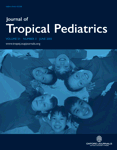-
PDF
- Split View
-
Views
-
Cite
Cite
A. Emin Kurekci, A. Avni Atay, S. Umit Sarici, Ediz Yesilkaya, Zeynep Senses, Vedat Okutan, Okan Ozcan, Is There a Relationship Between Childhood Helicobacter Pylori Infection and Iron Deficiency Anemia?, Journal of Tropical Pediatrics, Volume 51, Issue 3, June 2005, Pages 166–169, https://doi.org/10.1093/tropej/fmi015
Close - Share Icon Share
Abstract
An association between Helicobacter pylori infection and iron deficiency anemia has been reported in children, and it has been proposed that H. pylori infection needs to be eradicated to treat absolutely iron deficiency anemia (IDA). We investigated whether there was any correlation between H. pylori infection and iron deficiency (ID) and IDA in children, and whether the eradication of H. pylori infection without iron treatment would lead to the resolution of ID. Hemoglobin and ferritin levels, H. pylori stool antigen test and 14C urea breath test were measured in 140 children aged 6–16 years (median 9.5 years). Children with H. pylori infection were divided into three groups on the basis of hemoglobin, mean corpuscular volume (MCV), and serum ferritin levels: groups of IDA, ID, and control. All the children received anti-H. pylori combination therapy consisting of amoxicillin, clarithromycin, and lansoprazole. Hemoglobin and MCV values rose significantly compared with baseline values after H. pylori eradication without iron supplementation in children with IDA (p=0.002 and p = 0.003, respectively). Ferritin values increased significantly after H. pylori eradication in children with ID (p<0.001). We conclude that complete recovery of ID and IDA can be achieved with H. pylori eradication without iron supplementation in children with H. pylori infection.
Author notes
1Department of Pediatric Hematology, Gülhane Military Medical Academy, Ankara, Turkey, 2Department of Pediatrics, Gülhane Military Medical Academy, Ankara, Turkey, 3Department of Microbiology, Gülhane Military Medical Academy, Ankara, Turkey



Comments